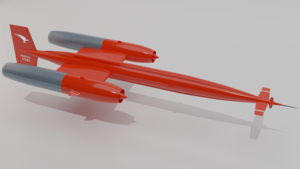| CT41 PQM-56 | |
|---|---|

| |
| Role | Target droneType of aircraft |
| National origin | France |
| Manufacturer | Nord Aviation |
| First flight | c.1959 |
| Introduction | 1960 |
| Retired | 1971 (U.S. Navy) |
| Primary users | French Air Force United States Navy |
| Number built | 62 |
The Nord CT.41 Narwhal was a French target drone, designed and built by Nord Aviation during the late 1950s for the purpose of providing training in the interception of supersonic bomber aircraft.
Design and development
Starting development in 1957, the CT.41 used a canard configuration, with a short, straight wing located at mid-fuselage with wingtip-mounted ramjet engines. Launched using an elevating ramp, two solid rocket boosters provided initial thrust upon launch, with the ramjets igniting at a speed of Mach 1.7. Command guidance was used for control; the aircraft could be fitted with electronic enhancers and flares to boost its target signature. Two types were produced, the CT.41A for high-altitude use, and the CT.41B for low-altitude training. If the drone was not shot down, recovery was via parachute.
Operational history
The CT.41 began test flights during 1959, with production starting later that year; 62 aircraft were constructed for use by the French Air Force. They had only a brief service life before being retired due to being too fast to provide practical training for interceptor pilots. Hawker Siddeley acquired a manufacturing license for the type in November 1960. Six were acquired by Bell Aircraft for evaluation by the United States Navy; Bell also acquired a production license for the type, which in 1962 received the U.S. designation PQM-56A. The PQM-56A was out of service by the early 1970s.
Specifications
Data from Directory of U.S. Military Rockets and Missiles (2003)
General characteristics
- Crew: None
- Length: 9.80 m (32 ft 2 in)
- Wingspan: 3.73 m (12 ft 3 in)
- Height: 2.18 m (7 ft 2 in)
- Gross weight: 1,297 kg (2,860 lb)
- Max takeoff weight: 2,550 kg (5,622 lb) with boosters
- Powerplant: 2 × Type 625 ramjet
Performance
- Maximum speed: Mach 3.1
- Endurance: 14 minutes
- Service ceiling: 20,000 m (65,000 ft)
References
Citations
- ^ "The 23rd Paris Show". Flight, 14 August 1959. p.20.
- ^ "Nord C.T.41". Flight, 12 August 1960, p.215.
- ^ Parsch 2003
Bibliography
- Parsch, Andreas (2003). "Nord/Bell CT.41/PQM-56". Directory of U.S. Military Rockets and Missiles. designation-systems.net. Retrieved 2014-05-09.
| Société nationale de constructions aéronautiques du Nord (SNCAN)/Nord Aviation aircraft | |||||||||||||||||||
|---|---|---|---|---|---|---|---|---|---|---|---|---|---|---|---|---|---|---|---|
| Manufacturer designations | |||||||||||||||||||
| By role |
| ||||||||||||||||||